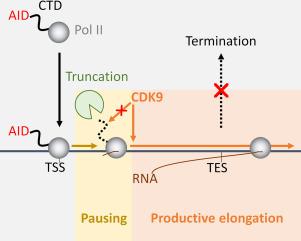Journal of Molecular Biology ( IF 5.6 ) Pub Date : 2020-07-21 , DOI: 10.1016/j.jmb.2020.07.010 Alan Gerber 1 , Robert G Roeder 1

|
Interest in the C-terminal domain (CTD) of the RPB1 subunit of the RNA polymerase II (Pol II) has been revived in recent years, owing to its numerous posttranslational modifications and its “phase-separation” properties. A large number of studies have shown that the status of CTD modifications is associated with the activity of Pol II during the transcription cycle. However, because this domain is essential in living cells, the functional requirement of the full CTD for the control of Pol II activity at endogenous mammalian genes has never been addressed directly in living cells. Using an inducible Pol II-degradation system that we previously established, we investigated here the roles of the CTD in the post-initiation control of Pol II. The selective ablation of the RPB1 CTD, post-initiation, at promoter-proximal pause-sites revealed that this domain, and by extension the CTD heptads and their modifications, is functionally neither absolutely required to maintain pausing in the absence of CDK9 activity nor essential for the release of Pol II into productive elongation.
中文翻译:

CTD 对于 RNA 聚合酶 II 活性的启动后控制不是必需的。
近年来,由于其众多的翻译后修饰和“相分离”特性,人们对 RNA 聚合酶 II (Pol II) 的 RPB1 亚基的 C 端结构域 (CTD) 的兴趣重新抬头。大量研究表明,CTD 修饰的状态与转录周期中 Pol II 的活性有关。然而,由于该结构域在活细胞中是必不可少的,因此从未在活细胞中直接解决过完整 CTD 用于控制内源性哺乳动物基因的 Pol II 活性的功能要求。使用我们之前建立的诱导型 Pol II 降解系统,我们在这里研究了 CTD 在 Pol II 的启动后控制中的作用。RPB1 CTD 的选择性消融,启动后,



























 京公网安备 11010802027423号
京公网安备 11010802027423号